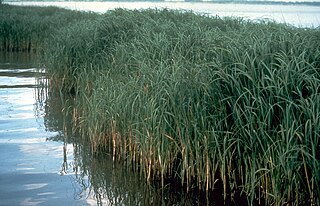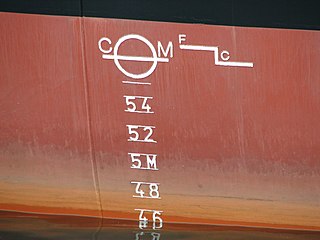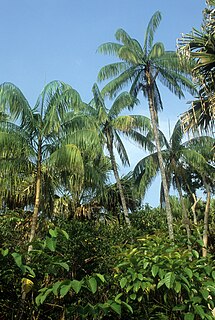Related Research Articles

Brackish water, also sometimes termed brack water, is water occurring in a natural environment having more salinity than freshwater, but not as much as seawater. It may result from mixing seawater with fresh water together, as in estuaries, or it may occur in brackish fossil aquifers. The word comes from the Middle Dutch root "brak". Certain human activities can produce brackish water, in particular civil engineering projects such as dikes and the flooding of coastal marshland to produce brackish water pools for freshwater prawn farming. Brackish water is also the primary waste product of the salinity gradient power process. Because brackish water is hostile to the growth of most terrestrial plant species, without appropriate management it is damaging to the environment.

A halophyte is a salt-tolerant plant that grows in soil or waters of high salinity, coming into contact with saline water through its roots or by salt spray, such as in saline semi-deserts, mangrove swamps, marshes and sloughs and seashores. The word derives from Ancient Greek ἅλας (halas) 'salt' and φυτόν (phyton) 'plant'. An example of a halophyte is the salt marsh grass Spartina alterniflora. Relatively few plant species are halophytes—perhaps only 2% of all plant species.

A mangrove is a shrub or small tree that grows in coastal saline or brackish water. The term is also used for tropical coastal vegetation consisting of such species. Mangroves occur worldwide in the tropics and subtropics, mainly between latitudes 25° N and 25° S. The total mangrove forest area of the world in 2000 was 137,800 square kilometres (53,200 sq mi), spanning 118 countries and territories.
Insular biogeography or island biogeography is a field within biogeography that examines the factors that affect the species richness and diversification of isolated natural communities. The theory was originally developed to explain the pattern of the species–area relationship occurring in oceanic islands. Under either name it is now used in reference to any ecosystem that is isolated due to being surrounded by unlike ecosystems, and has been extended to mountain peaks, seamounts, oases, fragmented forests, and even natural habitats isolated by human land development. The field was started in the 1960s by the ecologists Robert H. MacArthur and E. O. Wilson, who coined the term island biogeography in their inaugural contribution to Princeton's Monograph in Population Biology series, which attempted to predict the number of species that would exist on a newly created island.

The waterline is the line where the hull of a ship meets the surface of the water. Specifically, it is also the name of a special marking, also known as an international load line, Plimsoll line and water line, that indicates the draft of the ship and the legal limit to which a ship may be loaded for specific water types and temperatures in order to safely maintain buoyancy, particularly with regard to the hazard of waves that may arise. Varying water temperatures will affect a ship's draft, because warm water is less dense than cold water, providing less buoyancy. In the same way, fresh water is less dense than salinated or seawater with the same lessening effect upon buoyancy.

Avicennia marina, commonly known as grey mangrove or white mangrove, is a species of mangrove tree classified in the plant family Acanthaceae. As with other mangroves, it occurs in the intertidal zones of estuarine areas.

A mangrove swamp is a distinct saline woodland or shrubland habitat formed by mangrove trees in brackish tidal water. They are characterized by depositional coastal environments, where fine sediments collect in areas protected from high-energy wave action. The saline conditions tolerated by various mangrove species range from brackish water, through pure seawater, to water concentrated by evaporation to over twice the salinity of ocean seawater.

The Godavari-Krishna mangroves are a mangrove ecoregion of India's eastern coast.

Avicennia germinans, the black mangrove, is a shrub or small tree to 12 meters (39') in the acanthus family, Acanthaceae. It grows in tropical and subtropical regions of the Americas, on both the Atlantic and Pacific Coasts, and on the Atlantic Coast of tropical Africa, where it thrives on the sandy and muddy shores where seawater reaches. It is common throughout coastal areas of Texas and Florida, and ranges as far north as southern Louisiana and coastal Georgia in the United States.

Chira Island is a 4,300-hectare (11,000-acre) Costa Rican Pacific island located at the upper end of the Gulf of Nicoya it is also as Chira a district of the Puntarenas canton, in the Puntarenas province of Costa Rica.

Royal Burgers' Zoo is a 45-hectare (110-acre) zoo in Arnhem, Netherlands, and is one of the biggest zoos in the country. Arnhem is a city that lies within the Veluwe, a nature park in the east of the Netherlands. The zoo is popular with both Dutch and German people, and receives about 1.5 million visitors annually. It was founded by Johan Burgers in 1913.

The yellow-capped pygmy parrot is a species of parrot in the family Psittacidae found in Indonesia and Papua New Guinea. Its natural habitats are subtropical or tropical moist lowland forest, subtropical or tropical mangrove forests, and subtropical or tropical moist montane forest. Like many parrots, this pygmy parrot is affectionate to its mate. It is currently unknown if they remain monogamous for life like many bigger parrots because of their isolated location, which is difficult to reach.

The yellow-billed cotinga is a species of bird in the family Cotingidae. It is found in the Pacific lowlands of Costa Rica and Panama. Its natural habitats are subtropical or tropical moist lowland forest, subtropical or tropical mangrove forest, and subtropical or tropical moist shrubland. It is threatened by habitat destruction.

Oncosperma tigilarium is an Asian species of palm tree in the family Arecaceae.

Salt ponds are a natural feature of both temperate and tropical coastlines. These ponds form a vital buffer zone between terrestrial and marine ecosystems. Contaminants such as sediment, nitrates and phosphates are filtered out by salt ponds before they can reach the ocean. The depth, salinity and overall chemistry of these dynamic salt ponds fluctuate depending on temperature, rainfall, and anthropogenic influences such as nutrient runoff. The flora and fauna of tropical salt ponds differ markedly from those of temperate ponds. Mangrove trees are the dominant vegetation of tropical salt pond ecosystems, which also serve as vital feeding and breeding grounds for shore birds.

Blue carbon refers to carbon dioxide removed from the atmosphere by the world's ocean ecosystems, mostly algae, mangroves, salt marshes, seagrasses and macroalgae, through plant growth and the accumulation and burial of organic matter in the soil.

Sirinat National Park is a national park in Phuket Province, Thailand. This park, with sections on land and sea, is in the northwest of the island of Phuket.

The Esmeraldas-Pacific Colombia mangroves (NT1409) is an ecoregion of mangrove forests along the Pacific coast of Colombia and Ecuador. It is threatened by human population growth, leading to over-exploitation for wood and clearance for farming and aquaculture.
Marivivens donghaensis is a Gram-negative and aerobic bacterium from the genus of Marivivens which has been isolated from seawater from the Sea of Japan in Korea.

The Petenes mangroves ecoregion covers mangrove habitat along the Gulf of Mexico coast of southern Mexico, where Campeche state and Yucatan state meet, centering on the Celestun Lagoon inland from the barrier-island town of Celestún. Because the region has relatively little rainfall and no rivers feeding the lagoons, the freshwater to support the mangrove ecosystem springs from underground aquifers. The area is important for migratory birds, and as a nesting area for sea turtles. The area around the Celestun Lagoon is protected by the Celestun Biosphere Reserve, a UNESCO Biosphere Reserve.
References
- 1 2 Parte, A.C. "Marivivens". LPSN .
- 1 2 "Marivivens niveibacter". www.uniprot.org.
- ↑ Hu, D; Wang, L; Lai, Q; Sun, F; Shao, Z (February 2018). "Marivivens niveibacter sp. nov., isolated from the seawater of tropical mangrove". International Journal of Systematic and Evolutionary Microbiology. 68 (2): 570–574. doi: 10.1099/ijsem.0.002544 . PMID 29388535.
| This Rhodobacterales article is a stub. You can help Wikipedia by expanding it. |